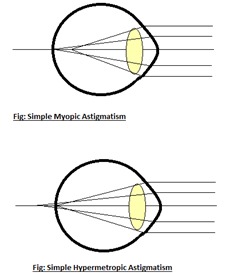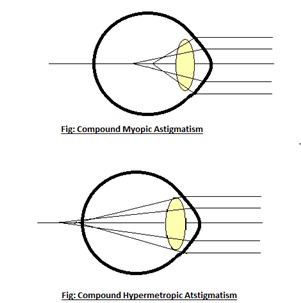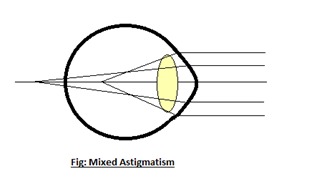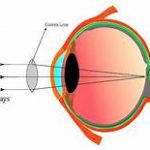The refractive errors the world is dealing now a days ASTIGMATISM is one of them.
In Astigmatism the parallel rays coming from infinity are refract and focus but they don’t IP by a focal point, they form two focal line.
It is one of the leading cause for visual impairment among the mankind.
The awareness of astigmatism is really questionable among the ordinary people.
Untreated Astigmatism can lead to a person to Meridonial Amblyopia which is a non-curable visual impairment.
Let’s discuss about the types of ASTIGMATISM
Broadly the Astigmatism has two types:
- Regular Astigmatism
- Irregular Astigmatism
Types of Regular Astigmatism:
Etiologically Regular Astigmatism can be defined as 3 ways
- Corneal Astigmatism: This type of regular Astigmatism caused by the congenital unusual curvatural difference between the two principal meridian of the refractive surface of the eye, Cornea. It is the commonest cause for Astigmatism within the patients.
- Lenticular Astigmatism: It is a rare type. But it can be classified as 3 parts
- Curvatural: It happened due to small amount of curvatural defects of crystalline lens due to abnormal growth of child. It is congenital.
- Positional: The small degree of tilting of crystalline lens can cause Positional Lenticular Astigmatism. It’s also can be congenital. The oblique placement of lens due to trauma can also be seen. Subluxation of lens is one of the example of this.
- Index: This type of astigmatism occurs due to the different refractive index in different meridian of lens of the patient suffering from Diabetes, developed Nuclear Sclerosis and Cataract. It is rare type.
- Retinal Astigmatism: It occurs due to oblique positioning of macula. Though it happens rarely.
Types of Regular Astigmatism based on the relation between the two principal axis:
- With-the-rule Astigmatism: When the Vertical meridian is more curved than Horizontal meridian then it is called With-the-rule Astigmatism. In this type the two principal meridian are placed at the right angle to each other. Due to steeper vertical meridian concave cylinder 180° or convex cylinder 90° lens is given as correction for this.
- Against-the-rule Astigmatism: In this astigmatic error, the Horizontal meridian is more curved than the Vertical meridian. For this correction of concave cylinder 90° or convex cylinder 180° lens will require.
- Oblique Astigmatism: By the name of this astigmatic error we can easily understood that the principal meridian are not vertical and horizontal rather than their position is oblique (e.g. one meridian is 60° another is 150°). But the maintain the difference of the angle between them. Oblique Astigmatism is found symmetrical between the two eyes.
- Bi-oblique Astigmatism: In this type of astigmatism the two meridian do not maintain the angle difference between them (e.g. one meridian is 20° another is 80°)
The refractive types of Regular ASTIGMATISM:
Previously we have discussed that, in Astigmatism the parallel rays of light do not form a focal point but form two focal lines. Depending upon the two principal meridian with its correlation with the neurosensory layer retina it can be classified into followings.
- Simple Astigmatism: Thereupon one of the principal meridian is formed on the retina and the other one is formed either In front or behind the retina.
If the other principal meridian is in front of the retina then it is called Simple Myopic Astigmatism.
Accordingly, if the other principal meridian is formed behind the retina it’s called Simple Hypermetropic Astigmatism. 
- Compound Astigmatism: In this type of astigmatism both the meridian is formed either in front of the retina, which is called Compound Myopic Astigmatism, or behind the retina, which is called Compound Hypermetropic Astigmatism, sequentially.

- Mixed Astigmatism: It refers to a condition in which one meridian is formed in front of the retina and another one is formed behind the retina. Therefore, one meridian is Myopic and another meridian Hypermetropic.

Types of Irregular Astigmatism:
Irregular Astigmatism refers to an irregular change of refractive power in different meridian. The presence of multiple meridian is seen, which admit no geometrical analysis.
Etiological types:
- Corneal Irregular Astigmatism is found in the patients with Keratoconus, Corneal scar, after pterygium excision etc.
- Lenticular Irregular Astigmatism Is found in crystalline lens due to different refractive index in different parts of the lens. It can be seen during maturation of cataracts.
- Retinal Irregular Astigmatism Is caused in order to distortion of macula due to tumors of choroid pushing the macula, scarring etc.
The progression of ASTIGMATISM can be treated easily. To get relief from it patients just need to go to an eye care professional (Optometrist and Ophthalmologist) and check their eyes on daily basis.










